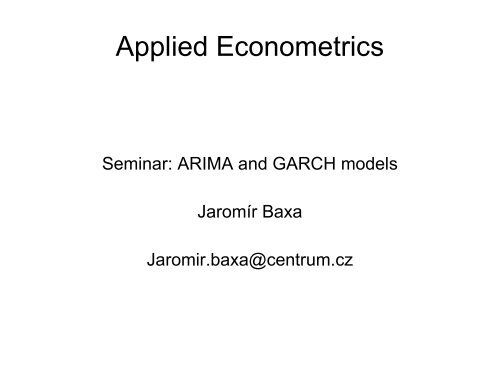Applied Econometrics
Applied Econometrics
Applied Econometrics
Create successful ePaper yourself
Turn your PDF publications into a flip-book with our unique Google optimized e-Paper software.
<strong>Applied</strong> <strong>Econometrics</strong><br />
Seminar: ARIMA and GARCH models<br />
Jaromír Baxa<br />
Jaromir.baxa@centrum.cz
Outline<br />
● ARMA and ARIMA models<br />
● Box-Jenkins method and fitting ARIMA models<br />
● Diagnostics of ARIMA models – ACF, PACF,<br />
formal tests and information criteria<br />
● GARCH models and modelling volatility:<br />
intuition<br />
● ARCH-LM test, fitting GARCH models
ARMA and ARIMA Models<br />
● Just the essence from the lecture:<br />
● AR(p)...y t = μ + Φ 1 y (t-1) +...+ Φ p y (t-p) + ε t ;<br />
● MA(q)...y t = μ + ε t – θ 1 ε t-1 – … – θ q ε t-q<br />
● ARMA (p,q):<br />
y t = μ + Φ 1 y (t-1) +...+ Φ p y (t-p) + ε t - θ 1 ε t-1 -…- θ q ε t-q<br />
● ARIMA (p,d,q):<br />
Δ d y t = μ + Φ 1 Δ d y (t-1) +...+ Φ p Δ d y (t-p) + ε t - θ 1 ε t-1 -…- θ q ε t-q
Box-Jenkins methodology<br />
● Recall: purpose of ARIMA models – univariate<br />
decomposition of time series, goal: extract all<br />
statistically significant components<br />
● Box-Jenkins methodology:<br />
● Identification: stationarity and order of<br />
integration, identify p and q.<br />
● Estimation: use software package and do not<br />
care about the details (usually non-linear least<br />
squares or maximum likelihood method).<br />
● Model Validation: ACF and PACF insignificant,<br />
minimized information criteria.
ARIMA models in JMulti<br />
● Data: PX/PX-50 index and CEZ stock 2001-06<br />
● In a lecture: does the PX50 time series follows<br />
the random walk? The result is that it is not.<br />
● Stationarity? Order of integration to achieve<br />
stationarity? Use the ADF test.<br />
● ACF and PACF of transformed series. What<br />
number of p and q?<br />
● Estimation and analysis of residuals.<br />
● Note: automatic model selection with the<br />
Hannan-Rissanen procedure: h...ĺogT
Diagnostics of ARIMA models<br />
● Resulting residuals should be white noise<br />
● White noise:<br />
=> zero mean and no autocorrelations, thus<br />
Ljung-Box statistics or Portmanteau statistics<br />
insignificant and ACF and PACF bars within<br />
„bands“ - 95% confidence intervals, that the<br />
true value equals zero, usually approximated as<br />
+/- 2/√T.<br />
● Information criteria: to find the best in the tradeoff<br />
between parsimony and R-sq.
Comments to the results<br />
● Still some siginificant autocorrelations<br />
● Reason: heteroscedasticity, non-normality and<br />
other assumptions violated.
ARCH and GARCH models<br />
● Motivation: homoscedasticity is to restrictive<br />
assumption.<br />
● See the plot of squared residuals of CEZ stock<br />
from ARIMA (1,1,1):
GARCH and ARCH - Summary<br />
● ARCH – Autoregressive conditional<br />
heteroscedasticity: variance depends on past<br />
variance<br />
● GARCH – generalized autoreg. cond. het.: variance<br />
is a weighted average of long-run variance (ω), the<br />
last period forecasted var. for this period (σ) and<br />
variance implied by most recent square residual (ε).<br />
● Formally:<br />
● ARCH(q): σ 2 = E(u t ) 2 = ω + α 1 (ε t - 1 ) 2 + …+ α q (ε t - q ) 2<br />
● GARCH(p,q):<br />
σ 2 = ω+α 1 (ε t - 1 ) 2 +…+α q (ε t - q ) 2 + β 1 σ 2<br />
t – 1 + … + β p σ2<br />
t - p.
GARCH - Motivation again...<br />
● ACFand PACF of log returns (logs of first<br />
differences) – almost none significant (very<br />
common for financial time series) => ARIMA<br />
useless<br />
● Conclusion: price development not predictable.
● But: Squares of log returns – variance (under<br />
the assumption of zero mean, which usually<br />
holds) – has significant autocorrelations:<br />
● Clustered volatility, which is persistent and thus<br />
predictable
GARCH in JMulti<br />
● Window ARCH Analysis.<br />
● But first, save the residuals from the ARIMA<br />
model: Model Checking => Plot/Add Residuals<br />
=>Add to dataset.<br />
● Switch to ARCH panel<br />
● Select GARCH or ARCH or TARCH models,<br />
parameters and execute the test.<br />
● Results should be white noise, have no<br />
autocorrelations... (see from diagnostics)<br />
● Note: this two equation method less efficient
● Plots for residuals of CEZ ARIMA (1,1,1)
Some closing considerations<br />
● TGARCH – see the lecture for the formulas –<br />
whether bad piece of news influences volatility.<br />
Here insignificant.<br />
● Several autocorrelations still significant. Why?<br />
1) Always some difficulties with real data. 2)<br />
Perhaps some seasonalities – day of the week<br />
effect. However for this dataset not applicable<br />
as days in the week with no trade were (by me<br />
some months ago – unfortunatelly) deleted.


